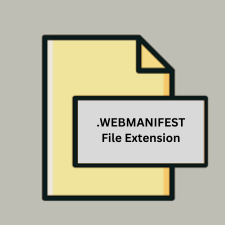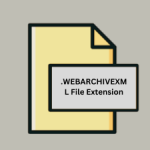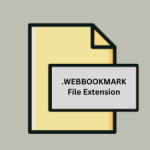.WEBMANIFEST File Extension

Progressive Web Application Manifest
| Developer | W3C |
| Popularity | |
| Category | Web Files |
| Format | .WEBMANIFEST |
| Cross Platform | Update Soon |
What is an WEBMANIFEST file?
A .webmanifest file is used in Progressive Web Applications (PWAs) to provide metadata about the app. This file is essential for PWAs as it helps define how the app should appear and behave when installed on a user’s device.
More Information.
The concept of web manifests began to take shape as the need for a standardized way to describe web applications emerged. Initially, the idea was to allow web applications to offer a richer, more integrated user experience similar to native apps. The .webmanifest format formalized this by providing a structured way to include metadata such as application name, icons, and display preferences.
Origin Of This File.
The .webmanifest file is part of the web standards defined by the World Wide Web Consortium (W3C) and the Web Platform Incubator Community Group (WICG). It was introduced to enable web applications to have native app-like experiences, including the ability to be added to the home screen, customized with a specific icon, and launched in a standalone window.
File Structure Technical Specification.
- File Format: The
.webmanifestfile is a JSON file. - Structure: It includes key-value pairs in JSON format that specify various properties of the PWA.
How to Convert the File?
Windows
- Text Editors:
- Use text editors like Notepad++, Sublime Text, or VSCode.
- Open the
.webmanifestfile in the editor. - Make changes or convert the JSON data into another format if needed (e.g., CSV or XML) using built-in tools or extensions.
- Save the file with the desired format and extension.
- Conversion Tools:
- Online tools or libraries can convert JSON data to other formats. You can use online JSON to CSV/XML converters or write scripts in languages like Python or JavaScript.
Linux
- Text Editors:
- Use text editors like Gedit, Vim, or VSCode.
- Open the
.webmanifestfile. - Edit or convert the JSON data using the text editor or script.
- Save the file in the desired format.
- Command-Line Tools:
- Use command-line utilities like
jqfor JSON manipulation or conversion. - Example command to convert JSON to CSV.
- Use command-line utilities like
MAC
- Text Editors:
- Use TextEdit, Sublime Text, or VSCode.
- Open the
.webmanifestfile. - Edit or convert the JSON data as needed.
- Save the file in the desired format.
- Conversion Tools:
- Online converters or tools like
jqcan be used to manipulate or convert JSON data.
- Online converters or tools like
Android
- Text Editors:
- Use apps like QuickEdit or Dcoder.
- Open the
.webmanifestfile. - Edit or convert the JSON data using the app’s features.
- Save the file with the desired format.
- Online Tools:
- Use web-based conversion tools in a browser on your Android device to convert JSON data to other formats.
iOS
- Text Editors:
- Use apps like Textastic or Koder.
- Open the
.webmanifestfile. - Edit or convert the JSON data using the app.
- Save the file in the desired format.
- Online Tools:
- Use online JSON converters through a web browser on your iOS device.
Others
- Web Servers:
- If you need to convert
.webmanifestfor web deployment, ensure it is correctly referenced in your web server configuration and converted to the correct MIME type if necessary (usuallyapplication/manifest+json).
- If you need to convert
- Development Tools:
- Use development environments and tools that support JSON manipulation and conversion, such as web development IDEs and online JSON editors.
Advantages And Disadvantages.
Advantages:
- Enhanced User Experience: Provides a native app-like experience for web apps.
- Customization: Allows customization of the app’s appearance and behavior.
- Offline Capabilities: Can work offline and be added to the home screen, improving accessibility.
Disadvantages:
- Limited Support: Older browsers may not fully support PWAs or
.webmanifestfiles. - Maintenance: Requires ongoing updates and maintenance to ensure compatibility with browser updates.
How to Open WEBMANIFEST?
Open In Windows
- Browsers: Modern web browsers (e.g., Google Chrome, Firefox) can read and use
.webmanifestfiles if they are linked properly in a web page. - Text Editors: Can be opened and edited with text editors like Notepad++, Sublime Text, or VSCode.
Open In Linux
- Browsers: The same as Windows—any modern web browser will support
.webmanifestfiles. - Text Editors: Use text editors like Gedit, Vim, or VSCode to open and edit
.webmanifestfiles.
Open In MAC
- Browsers: Modern browsers on macOS (e.g., Safari, Chrome, Firefox) will support
.webmanifestfiles. - Text Editors: Text editors like TextEdit, Sublime Text, or VSCode can be used to open and edit these files.
Open In Android
- Browsers: PWAs can be used directly through browsers that support them, like Chrome for Android.
- Text Editors: Files can be viewed and edited using apps like QuickEdit or Dcoder.
Open In IOS
- Browsers: PWAs can be accessed through browsers that support them, such as Safari on iOS.
- Text Editors: Use text editor apps like Textastic or Koder for viewing and editing
.webmanifestfiles.
Open in Others
- Web Servers:
.webmanifestfiles are often served by web servers as part of a PWA deployment. - Development Tools: Many development tools and environments that support web development can handle
.webmanifestfiles.













